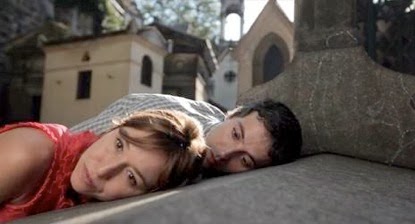Faulkner,
S. (2013) - A History of Spanish Film:
Cinema and Society 1910-2010, London: Bloomsbury. ISBN: 9780826416674
This book
uses the concept of Spanish middlebrow cinema to explore the representation of
class and social mobility across a century of Spanish cinema: 'A History of Spanish Film explores,
first, the cinema's representation of upwardly and downwardly mobile groups
on-screen, and places this representation, second, alongside class realignments
in Spanish society off-screen' (p.1). As Faulkner points out in her
introduction, by examining Spanish cinema decade-by-decade rather than the
traditional narrative of 'key dates' approach (often centring on whether a film
is pre- or post-1975), she manages to uncover continuities at the beginning and
end of the 1970s. But by focussing on 'an original terrain that was in-between
previous "art" and "popular" alternatives' she also traces
the 'middlebrow' through Spanish cinema from the 1970s onwards, arguing for the
presence of a greater consistency and continuity in the Spanish cinematic
output than is usually taken to be the case.
The close
textual analysis in combination with a nuanced reading of production, reception
and changes in taste in Spain gives new insights into a range of films,
including those that have already had acres written about them. From a personal
perspective, the section on Los lunes al
sol, which I'm intending to write about in relation to Javier Bardem's
performance style, has given me much food for thought not least because it
offers a more positive interpretation of its fusing of social realism and
melodrama (much decried by the likes of Ángel Quintana and others) and
has pointed me in the direction of other useful sources on the film as well.
I'm also planning to track down some of the films that I haven't seen. A really
interesting read.
As usual, I'm listing the table of contents below - I've listed the films English title first because that's how it's done in the book (I usually put the Spanish title first).
Introduction:
Cinema and Society 1910-2010
1.
Questions of Class and Questions of Art in Early Cinema
- Blood and
Sand (Sangre y arena -André and Ibáñez, 1916)
- Don Juan Tenorio
(de Baños, 1922)
- The
Grandfather (El abuelo -Buchs, 1925)
- The
Mystery of the Puerta del Sol (El misterio de la Puerta del Sol - Elías, 1929)
- The
Cursed Village (La aldea maldita -Rey, 1930)
- The Fair
of the Dove (La verbena de la paloma -Perojo, 1935)
2. Social
Mobility and Cinema of the 1940s and 1950s: Consolation and Condemnation
- The Nail
(El clavo -Gil, 1944)
- She, He
and His Millions (Ella, él y sus millones -Orduña, 1944)
- From
Woman to Woman (De mujer a mujer -Lucia, 1950)
- Furrows
(Surcos -Nieves Conde, 1951)
- That
Happy Couple (Esa pareja feliz -Bardem and Berlanga, 1951)
- Main
Street (Calle mayor -Bardem, 1956)
3.
Charting Upward Social Mobility: 1960s Films about the Middle Classes and the
Middlebrow
- Plácido (Berlanga, 1961)
- Life Goes
On (El mundo sigue -Fernán Gómez, 1963)
- Summer
Night (Noche de verano -Grau, 1962)
- The Happy
Sixties (Los felices sesenta -Camino, 1963)
- City Life
is not for Me (La cuidad no es para mí -Lazaga, 1966)
- Marisol's
Four Weddings (Las cuatro bodas de Marisol -Lucia, 1967)
4. The
'Third Way' and the Spanish Middlebrow Film in the 1970s
- Tristana
(Buñuel, 1970)
- Tormento
(Olea, 1974)
- Spaniards
in Paris (Españolas en París -Bodegas, 1971)
- My
Dearest Señorita (Mi Querida Señorita -Armiñán, 1972)
- Unfinished
Business (Asignatura pendiente -Garci, 1977)
- Daddy's
War (La guerra de papá -Mercero, 1977)
5. Miró Films and Middlebrow Cinema in the 1980s
- First
Work (Ópera prima -Trueba, 1980)
- Blood
Wedding (Bodas de sangre -Saura, 1981)
- The
Beehive (La colmena -Camus, 1982)
- Diamond
Square (La plaza del diamante -Betriu, 1982)
- Mambrú Went to War (Mambrú se fue a la guerra -Fernán Gómez, 1986)
- Half of
Heaven (La mitad del cielo -Gutiérrez Aragón, 1986)
6.
Middlebrow Cinema of the 1990s: From Miró to Cine social
- The
Dumbfounded King (El rey pasmado -Uribe, 1991)
- The
Flower of My Secret (La flor de mi secreto -Almodóvar, 1995)
- The Dog
in the Manger (El perro del hortelano -Miró, 1996)
- The
Grandfather (El abuelo -Garci, 1998)
- A Time
for Defiance (La hora de los valientes -Mercero, 1998)
- Alone
(Solas -Zambrano, 1999)
7. From Cine social to Heritage Cinema in Films
of the 2000s
- Mondays
in the Sun (Los lunes al sol -León de Aranoa, 2002)
- Take My
Eyes (Te doy mis ojos -Bollaín, 2003)
- Carol's
Journey (El viaje de Carol -Uribe, 2002)
- Soldiers
of Salamina (Los soldados de Salamina -Trueba, 2003)
- Alatriste
(Díaz Yanes, 2006)
- Lope
(Waddington, 2010)
I will
add the book to part 1 of the book list.
I've been
building up quite a stockpile of books on Spanish cinema recently, partly
because there have been an unusually high number published this year, but also
because I'm trying to expand my knowledge (concentrated on 1992 onwards)
backwards to encompass the 1980s and 1970s. The more-recently published books
on my 'to be read' pile include:
Delgado,
M.M. and R. Fiddian (ed.s) (2013) - Spanish Cinema 1973-2010: Auteurism,
politics, landscape and memory, Manchester: Manchester University Press.
Maurer
Queipo, I. (ed) (2013) - Directory of World Cinema: Latin America, Bristol:
Intellect Press.
Palacio,
M. (ed) (2011) - El cine y la transición política en España 1975-1982, Madrid: Editorial
Biblioteca Nueva, S.L.
Huerta
Floriano, M.Á. and E. Pérez Morán (ed.s) (2012) - El
"cine de barrio" tardofranquista: Reflejo de una sociedad, Madrid:
Editorial Biblioteca Nueva, S.L.
Aguilar,
J. (2012) - Las estrellas del destape y la transición: El cine español se desnuda, Madrid: T&B
Editores.
Benet,
V.J. (2012) - El cine español: Una historia cultural,
Barcelona: Paidós.
Expect
some of those to feature on here at some point in the future.










